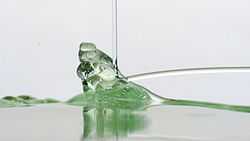Kaye effect

The Kaye Effect is a property of complex liquids which was first described by the British engineer Alan Kaye in 1963.[1]
While pouring one viscous mixture of an organic liquid onto a surface, the surface suddenly spouted an upcoming jet of liquid which merged with the downgoing one.
This phenomenon has since been discovered to be common in all shear-thinning liquids (liquids which thin under shear stress). Common household liquids with this property are liquid hand soaps, shampoos and non-drip paint. The effect usually goes unnoticed, however, because it seldom lasts more than about 300 milliseconds. The effect can be sustained by pouring the liquid onto a slanted surface, preventing the outgoing jet from intersecting the downward one (which tends to end the effect).
It is thought to occur when the downgoing stream "slips" off the pile it is forming, and due to a thin layer of shear-thinned liquid acting as a lubricant, does not combine with the pile. When the slipping stream reaches a dimple in the pile, it will shoot off it like a ramp, creating the effect.
References
- ↑ Kaye, A. (1963). "A Bouncing Liquid Stream". Nature 197 (4871): 1001. doi:10.1038/1971001a0.
External links
| Wikimedia Commons has media related to Kaye effect. |
- Puzzle of Leaping Liquid Solved.
- The Kaye effect using shampoo.
- The Kaye effect shot through a high speed camera.
- Leaping shampoo and the stable Kaye effect, M. Versluis, C. Blom, D. van der Meer, K. van der Weele and D. Lohse, University of Twente, The Netherlands.